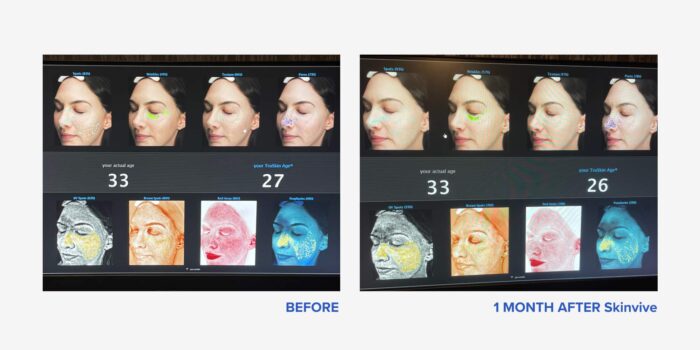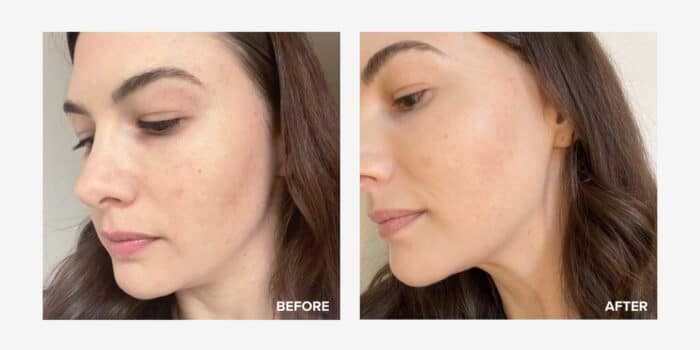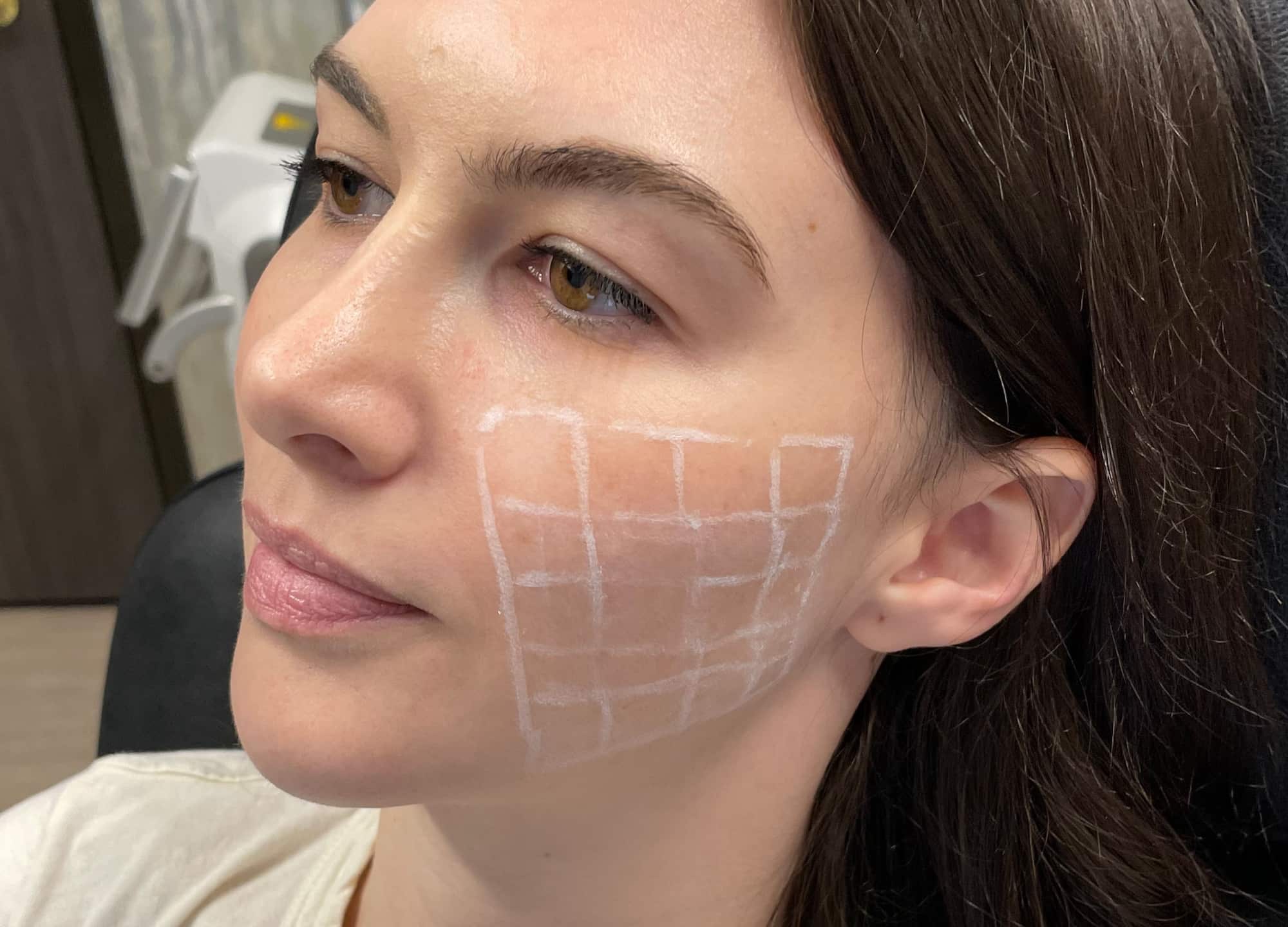The treatment
The provider
Dr. David Gilpin, a board-certified facial plastic surgeon in Nashville, Tennessee
What is Skinvive?
Skinvive is a thin hyaluronic acid gel that’s injected superficially into the top layers of the skin, to boost hydration levels, minimize the appearance of fine lines, improve cheek smoothness, and give an overall glow. It falls under a new category of injectables called “skin boosters,” and it’s the first of its kind in the U.S. to be FDA approved (Profhilo is a skin booster that’s popular in Europe but not yet available stateside).
It’s typically injected 20–25 times on each cheek, in a grid pattern (see image above). The full effects of the treatment can be seen at around the 30-day mark, and results last up to six months.
Skinvive vs. filler: What’s the difference?
Though Skinvive and filler have a similar composition of hyaluronic acid, the key difference is injection depth. Skinvive is injected very close to the surface of the skin using a microdroplet technique, with the goal of hydrating and improving overall skin quality, whereas filler is injected into the deeper layers, with the goal of building support, adding volume, and ultimately changing the shape of the face.
How much Skinvive costs
According to Allergan, Skinvive costs between $650 to $750 for two syringes—the standard amount used in clinical trials for both cheeks.
Who is a good candidate for Skinvive?
“Almost everyone is a good candidate,” says Dr. Gilpin, noting that pregnant and breastfeeding women are the exception. “Skinvive is recommended for all skin types—Fitzpatrick I through VI—ages 18 and above, and anyone who is looking for a glow or hydration or has crepey skin.”
I decided to try Skinvive in the middle of winter, when my skin was at its dullest, driest point and I hadn’t noticed any difference from a professional hydrating facial weeks earlier.
What my Skinvive treatment was like
First, I sat in front of a Visia imaging machine, which analyzes skin’s true age by looking at wrinkles, texture, pore size, and pigmentation spots. I was 33 years old (I’m now 34), and the machine told me I had a skin age of 27. The nurse instructed me to keep my skin-care routine exactly the same in the month after my Skinvive treatment and said they’d test it again at my follow-up appointment, to see if my skin age had gotten younger.
In preparation for treatment, Dr. Gilpin and his nurse drew a grid of 20 boxes on each of my cheeks, to guide where they’d be placing the injections—40 in total. I have no issues with needles, but this sure would be daunting for someone with trypanophobia. I imagined Skinvive would feel more like the quick sting of a Botox injection versus the heavier discomfort of a filler injection (I describe it as a sludge being pushed through your skin, and I hate it). Instead, I felt nothing except for the light pinch of my skin as Dr. Gilpin worked his way across the grid. It also helps that Skinvive has lidocaine in the formula.
Immediately after the 30-minute treatment, both my cheeks were covered in little bumps at each injection point. Dr. Gilpin massaged them more aggressively than would be done after a filler injection, since there’s no risk of displacing this product outside its intended location. I could feel minor bumpiness for a couple of hours afterward, and my skin was flushed, like I’d just gotten out of a SoulCycle class, but I went about my day as usual and would classify Skinvive as a no-downtime treatment. I used a gentle cleanser and moisturizer that evening and avoided putting on makeup for a day, just to be safe.
In the three weeks that followed, I found that I could use a lighter cream than I’d previously been applying, because my skin wasn’t begging for hydration, but there wasn’t any difference in glow. Around the three-and-a-half- to four-week mark, I noticed a difference in texture and a subtle lightening of the redness on my cheeks that flares up in the winter whenever temperatures are harsh and my complexion is at its palest. In the months that followed, the biggest result of the treatment was just how soft, hydrated, and healthy my skin felt after I took my makeup off and washed my face at night—there was no uncomfortable tightness or flakiness.
My Skinvive results

Sure enough, at my follow-up appointment a month later, the Visia machine showed that my skin had indeed de-aged—from 27 to 26—with an improvement in almost all areas (the closer the percentage is to 100, the better).

If I’m being honest, it was very difficult to take photos that showed a difference. I tried multiple times over the course of a week, and this after photo is the only one where you can tell that the patch of reddish discoloration on my cheek has faded. And although I believe Skinvive played a part, I would attribute this more to keeping up with the same skin-care routine I’d been doing the month prior to treatment, which involved using an expensive lactic acid serum and retinol a few times per week.
Overall, I could feel the results more than I could see them. I wish I could say that strangers and friends alike stopped to tell me how radiant I looked, but that wasn’t the case. Not to blow my own horn, but I have had good skin my entire life—my biggest issue is dryness, I’ve never struggled with breakouts, and I use medical-grade skin-care products—so I was never going to be the ideal candidate for a dramatic before-and-after.
Final verdict
While my face felt softer after the treatment, discoloration was less noticeable, and the Visia analysis showed that Skinvive had had an undeniable positive effect on my overall skin health and age, I simply didn’t notice a difference significant enough to justify the price of the treatment every six months.
As I approach 35 in December, Botox and conservative amounts of filler in my cheeks, temples, and jawline show greater returns on investment. I would, however, love to get Skinvive again before a big event, like my wedding; when my skin is in another superdry stage; or when I start to notice more crepiness on my neck (the injectable isn’t yet FDA approved to treat areas other than the cheeks, but doctors commonly use it off label, on the neck and décolletage).











